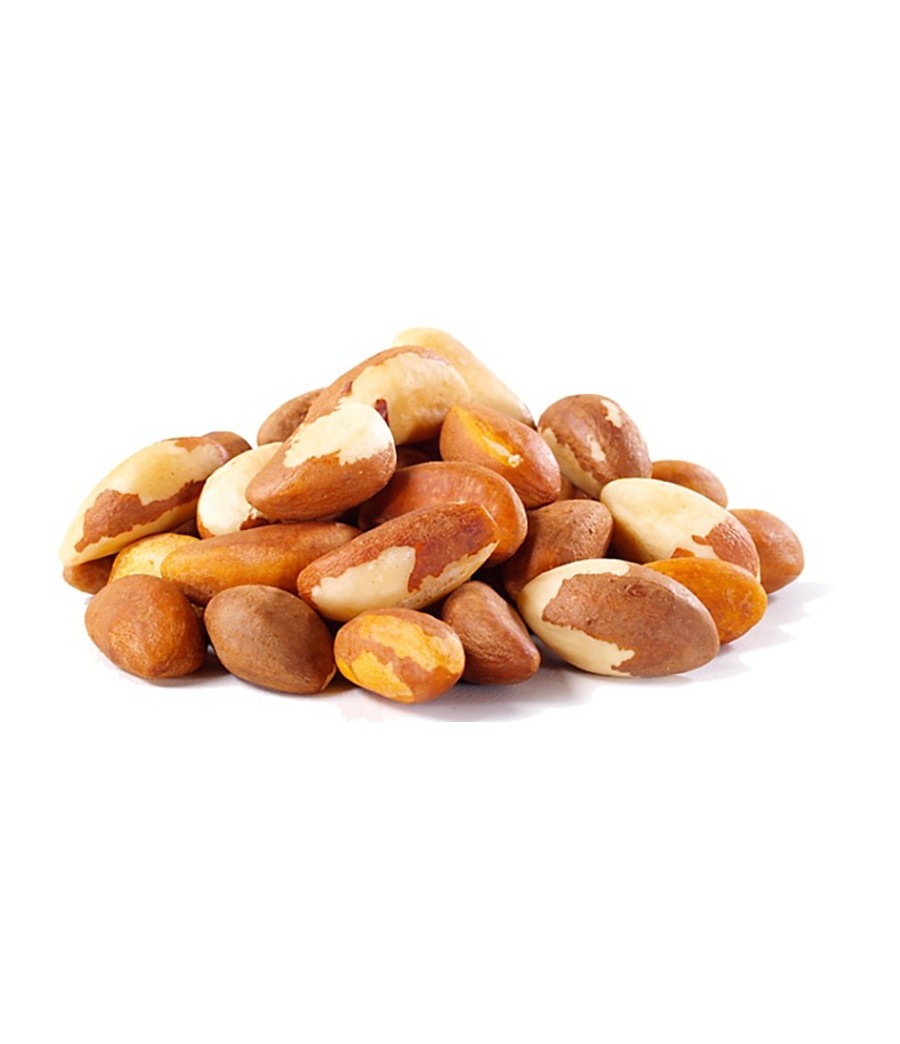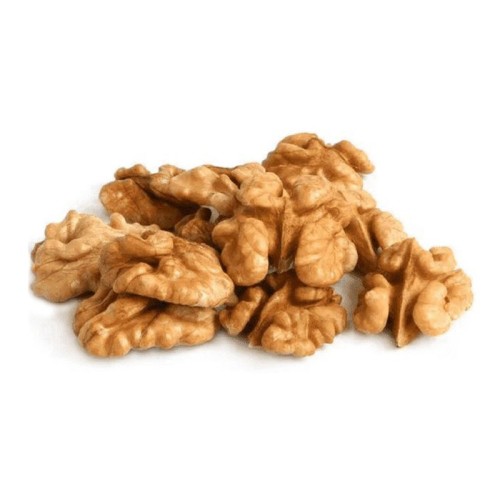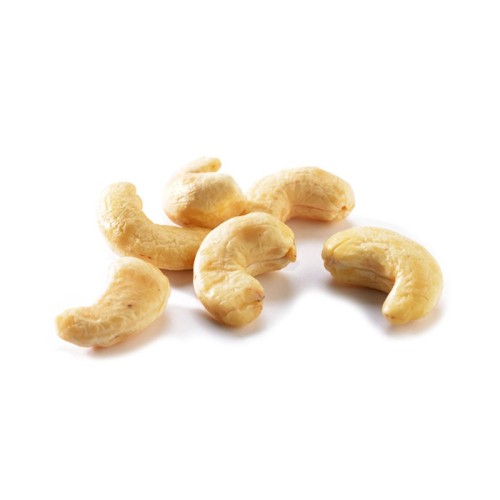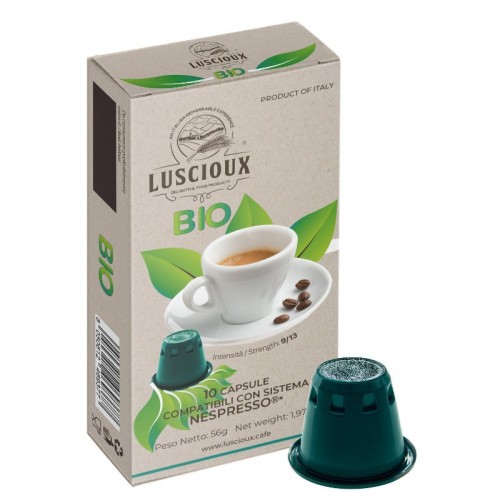Brazil Nuts "From the Amazon"
(€16.27 Per Kg)
 Security policy
Security policy
Transparency and reliability - Encrypted information (SSL Certificate)
 Delivery policy
Delivery policy
Fast shipping with delivery in 1- 4 working days.
 Return policy
Return policy
24/7
Amazon nuts, also known as Brazil nuts, are the seeds collected from a massive and long-lived tree that grows wild in the forests of South America. In fact, unlike the fruit nut widespread and cultivated in Europe, this plant is not cultivated and its fruits are harvested only when, once ripe, they fall to the ground
Data sheet
- Product
- Walnuts
Specific References
- ean13
- 8054134415980
Nutritional values
| Ingredients | BRAZIL NUTS. May contain traces of PEANUTS and other NUTS |
| Method of conservation | Keep in a cold and dry place. |
| Nutrition declaration | average values per 100 g: |
| Power | 2799kJ / 679kcal |
| Fats | 65.0 g |
| of which saturated fatty acids | 16 g |
| Carbohydrates | 2.2 g |
| of which sugars | 1.8g |
| Fibers | 8.4g |
| Protein | 17.1 g |
| Salt | 0.03g |
| Copper | 1.8mg (180% NRV) |
| Selenium | 225 µg (409% NRV) |
| Magnesium | 371 mg (99% NRV) |
| Directions | The advice given IS NOT IN ANY WAY TO BE CONSIDERED OF MEDICAL/PRESCRIPTIVE VALUE. The information provided is for informational and informative purposes only, therefore they are not intended in any way to replace medical advice. In the presence of pathologies you should always consult your doctor. |
| Origin | Brazil |
| Nutrients | Magnesium, Copper, Selenium |
| Vnr | *Nutritional Reference Value |
| Label and packaging | The images are included for illustrative purposes, the product may undergo changes based on stock availability and the selected weight. |
| Product | Nuts |
Curiosity
There brazil nut, Amazon nut (Bertholletiaexcelsa) or Brazil nuts , is obtained from the large fruits of a large tree belonging to the Lecythidaceae family which is widespread in all tropical regions, even if most of the species are present in the neotropics, especially in the Amazon basin. The Brazil nut grows wild in Venezuela, Guyana, Colombia, Ecuador, Brazil, Bolivia and Peru. However, it can also be cultivated outside its normal habitat, in fact it is present in many botanical gardens in Cuba, Sri Lanka, Kuala Lumpur, Malaysia, Ghana and South West Asia. However, only in Brazil, Bolivia and Peru there are walnut trees with a production that allows them to be exported. The tree can grow to measure more than 50 meters high and has a stem that reaches two meters in diameter, it is one of those trees defined as emerging in the tropical forest. It can reach 500-800 years of life. THE flowers they are small, white-yellow and fleshy arranged in panicle inflorescences. The flowers of the Brazil nut have a unique shape in the world which does not facilitate its pollination, so much so that the Brazil nut is known to be pollinated only by a particular species of very vigorous bees, which thanks to its strength manages to penetrate inside the flower. THE large woody fruits , known in botany as pixids, about the size of a coconut , they reach weights of even more than 2 kg. Each fruit contains on average between 12 and 20 clove-shaped seeds, the actual nuts also protected by a rough woody shell. Each plant produces an average of 30/40 kilograms per year. In the world market of dried fruit Brazil nut is the only species whose production is obtained exclusively from natural areas through manual harvesting of the fruit. There Brazil nut it is collected during the rainy period, December-March, by local collectors, called castagneros , who temporarily move to the forest, often with their families, to pick the fruit. Each binder deals with one pathway or forest sector which he periodically travels to collect the fallen fruit. In the wild, this fruit is only opened by the agouti, a large forest rodent, or, over a longer period, by termites. The empty shells of the fruit, in some regions called "monkey cup", are used by the natives to carry small fires, which with their smoke keep the insects away; or farmers use them to collect the rubber that comes out of the bark of the engraved trees of the same name or they are simply used for drinking. From the unripe and grated seeds a latex is obtained which is locally used together with coffee as milk. In addition to food use, Brazil nut oil is also used as a lubricant for watches, as a base for artists' colors and in the cosmetic industry.
Sources:
Nutspaper “Brazil Nut” 2/2009
History
Bertholletia excelsa , commonly known as Brazil nut or Amazon nut (commercial name brazil nut) is obtained from the large fruits of a large tree belonging to the Lecythidaceae family widespread in all tropical regions, even if most of the species are present in the neotropic, especially from the Amazon Basin.
The name of the species , in honor of the French scientist Claude-Louis Berthollet, was published for the first time in 1807 by the two botanists Humboldt and Bonpland in Plantaeaequinoctiales. In 1874, Miers, in Trans. Linn. Soc. London, presented it instead with the name of Bertholletianobilis. The export of the walnut began in the 17th century with Dutch merchants. At the beginning of the 19th century, the Amazon nut was exported through two ports in Pará; which is why from the beginning it was known as Castanha-do-Pará; only later did the Brazilian Ministry of Agriculture give it the name of Castanha-do-Brasil. From 1818 it began to be the most important product exported from Pará and, after 1847, its marketing acquired an appreciable economic value. However, the statistical export registers mention it only starting from 1899. The Castanha-do-Pará used to feed the Indians and domestic animals on a small scale, became one of the main sources of income in this region, giving work to a large number of workers both in the forest and in the cities.
Despite the trade name of Brazil nut, the world's leading producer is Bolivia , in the departments of Beni and Pando. The main world processing plants are located in the towns of Riberalta and Cobija. In South America, the forest where the Brazil nut grows covers 20 million hectares. In Peru, the production area is estimated to be around 1.8 million hectares, concentrated in the eastern part of the Department of Madre di Dios. 30% of the population of this region lives thanks to its trade. The volume of business generated by the export of walnuts - which began in the 17th century with Dutch merchants - is second only to that of rubber in the Amazon.
Sources
Nutspaper “Brazil Nut” 2/2009
storage
You can store shelled Brazil nuts in cool, dry places, away from sources of heat and humidity. Here are 4 useful tips:
- The ideal condition for maintaining Brazil nuts is in a refrigerated environment . Shelled Brazil nuts can also be stored without problems at room temperature during the winter season given the low temperatures. During the summer, on the other hand, it is advisable to keep it in the fridge or in the coolest possible place, as the increase in temperatures could favor the deterioration of the products.
- The ideal container in which to store Brazil nuts is glass . In fact, thanks to its constitution it is impenetrable to chemical and gaseous agents, and having excellent thermal insulating capacity it maintains the initial temperature for a longer time compared to other materials. If the glass is colored, so much the better: using colored glass prevents the entry of some wavelengths of light (including ultraviolet light) and therefore some nutritional and organoleptic characteristics remain unaltered.
- The type of closure of the container is also important: an airtight cap ensures that the food is protected from excessive contact with oxygen which can lead to lipid oxidation and which can be essential for aerobic bacteria.
- The environment should always be well ventilated : by ventilating the rooms, the internal humidity that escapes from the window is kept under control, guaranteeing the right balance, which helps to discourage the onset of moulds.
Recommended doses
30 g of Brazilian nuts provide:
- 124% of the nutritional reference value of Selenium;
- 54% of the nutritional reference value of copper;
- 30% of the nutritional reference value of Magnesium.
Individual needs vary according to age, gender, weight and physical activity. A varied and balanced diet and a healthy lifestyle are the basis of your well-being.
Property
100g of Brazil nuts shelled contain:
- Iron (2.7 mg - 19% NRV)
- Calcium (156 mg - 20% NRV)
- Potassium (582 mg - 29% NRV)
- Zinc (4.3 mg - 43% NRV)
- Vitamin E (5.3 mg - 44% NRV)
- Thiamine (0.63 mg - 57% NRV)
- Manganese (1.2 mg - 60% NRV)
- Phosphorus (665 mg - 95% NRV)
- Magnesium (371 mg - 99% NRV)
- Copper (1.8 mg - 180% NRV)
- Selenium (225 μg - 409% NRV)
- Fiber (8.4 g)
- Unsaturated fatty acids (49 g) and oleic acid (21 g).
- Linoleic acid (27 g)
Please note that Brazil nuts are included in the list of allergens (Annex 2 EU Reg. 1169/2011 and subsequent amendments)
No customer reviews for the moment.






